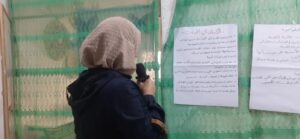Thousands of women and children have returned from Al-Hol Camp to different places in Syria since 2019. IMPACT, among other organizations, provide support to women and children who leave Al-Hol. There is little known about the post return circumstances and challenges these women and children face, and more importantly, any assessment of the perceived usefulness of the reintegration programs delivered to them. This study contributes to filling this gap.
Reintegration is understood here not an end goal, but instead as a step in a wider process of social cohesion and material welfare building. From this perspective, this study is guided by two interrelated questions: What challenges are exclusive to returnees from al Hol to the Northeast, in comparison to the residents of Northeast; and what is the perceived effectiveness of existing activities delivered to returnees? Research was conducted in two locations in Deir Ezzor: Hajin and Kasra, and the results reveal important findings and distinctions between the two sites.
To the authors’ knowledge, this is the first study of its kind to be undertaken in Deir Ezzor, and specifically in the localities of Hajin and Kasra. Hajin has attracted significant attention and programmatic support within the field of reintegration and CVE work, while Kasra has not received as much support. This research is one of few qualitative studies on reintegration in NES and is based on data collection with 83 women. In each locality: participants included women who had left al-Hol and who had taken part in reintegration activities; women who had left al-Hol and had not taken part in any reintegration activities; and residents in the local community.
The research findings suggest the following: 1) Access to services is not inherently discriminatory to returnees but is dependent on documents and availability. 2) Access to employment and livelihoods is equally limited for both returnees and residents. 3) Discrimination exists, but acceptance increases by time. 4) Returnee children are not prioritised by institutions. The research found important differences between the two sites with regards to access to services and essential goods and experiences of discrimination; but that in both locations women are profoundly concerned for the future and wellbeing of their children.
The field study also reflected on the perceptions of both returnees and resident women on reintegration programs implemented in the northeast of Syria. The main observation is that there are short-term benefits of reintegration activities, although there is little evidence that reintegration programmes lead to longer term outcomes, such as women’s ability to find work. That finding is a call for donors to reconsider the wider economic and political context when planning, designing, and evaluating future intervention programs. The interviewees also highlighted shortfalls in existing projects, and discussed existing barriers to joining reintegration activities, and identified priority areas for future reintegration activities.

